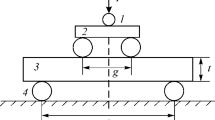Abstract
The failure mechanism of brittle solids under very short duration tensile loading differs basically from that under prolonged tensile loads. Under static loading, or long stress pulses, the initiation and propagation of a single inherent flaw may lead to complete separation of the part. By contrast, if the loading is of very short duration, many cracks have to initiate and propagate so that they can link up and create a fracture surface during the loading period. A simple theory is proposed which relates the strength values observed under short duration stress pulses to the distribution of inherent flaws in the material. The prediction is shown to compare favorably with experimental results obtained by subjecting several types of rock to electron beams which produce stress pulses lasting from fractions of a microsecond to several microseconds.
Résumé
Le mécanisme de rupture d'un solide fragile soumis à une charge de traction de courte durée diffère fondamentalement de celui obtenu par une mise en charge prolongée. Pour une charge statique ou dans le cas des impulsions à contrainte prolongée, l'initiation de la propagation d'un simple défaut inhérent peut conduire à une séparation complète des parties. Par contraste, si la mise en charge est de courte durée, plusieurs microfissures s'initient et se propagent de telle façon qu'elles peuvent s'enchainer et créer une surface de rupture pendant la période de charge. Une théorie simple est proposée reliant les valeurs de la résistance observée pour des impulsions de contraintes de courte durée à la distribution des défauts inhérents dans le matériau. Une corrélation favorable est démontrée avec les résultats expérimentaux obtenus en soumettant divers types de roches à l'action de faisceaux d'électrons durant des fractions de microsecondes et jusqu'à plusieurs microsecondes.
Similar content being viewed by others
References
W. Weibull, Ingvetenskakad, Handl., No. 151, Stockholm (1939).
H. L. Oh and I. Finnie, International Journal of Fracture Mechanics, 6 (1970) 287–300.
Ö Vardar and I. Finnie, International Journal of Fracture, 11 (1975) 495–508.
R. T. Avery, gnD. Keefe, gnT. G. Brekke and gnI. Finnie, IEEE Transactions on Nuclear Science, NS-20 (1973) 1010–1014.
S. A. Thau and T. H. Lu, International Journal of Solids and Structures, 7 (1971) 731–750.
G. C. Sih, G. T. Embley and R. S. Ravera, International Journal of Solids and Structures, 8 (1972) 977–993.
L. B. Freund, Journal of Mechanics and Physics of Solids, 21 (1973) 47–61.
J. D. Achenbach and R. Nuismer, International Journal of Fracture Mechanics, 7 (1971) 77–88.
G. T. Embley and G. C. Sih, Proceedings of 12th Midwestern Mechanics Conference, 6 (1971) 473–487.
N. F. Mott, Engineering, 165 (1948) 16–18.
D. K. Roberts and A. A. Wells, Engineering, 178 (1954) 820–821.
E. N. Dulaney and W. F. Brace, Journal of Applied Physics, 31 (1960) 2233–2236.
J. P. Berry, Journal of Mechanics and Physics of Solids, 8 (1960) 194–216.
Y. M. Tsai, Engineering Fracture Mechanics, 6 (1974) 509–522.
K. B. Broberg, Arkiv. für Fysik, 18 (1960) 159–192.
D. Hull and P. Beardmore, International Journal of Fracture Mechanics, 2 (1966) 468.
L. B. Freund, Journal of Mechanics and Physics of Solids, 20 (1972) 129–140.
H. Bergkvist, Journal of Mechanics and Physics of Solids, 21 (1973) 229–239.
K. B. Broberg, Recent Progress in Applied Mechanics (edited by Broberg, Hult, Niordsen), Almquist and Wiksell, Stockholm (1967) 125–151.
H. Bergkvist, ASTM Symposium on Fast Fracture and Crack Arrest, Chicago, June (1976).
T. L. Paxson and R. A. Lucas in “Dynamic Crack Progagation”, G. C. Sih ed., Noordhoff, Leyden (1973) 415–426.
L. B. Freund, Journal of Mechanics and Physics of Solids, 22 (1974) 137–146.
R. F. Tuler and B. M. Butcher, International Journal of Fracture Mechanics, 4 (1968) 431–437.
A. S. Argon, Proceedings of the Royal Society, (London), A250 (1959) 472–482.
F. A. McClintock, in Fracture Mechanics of Ceramics, R. C. Bradt, et al., editors, Plenum Press (1974) 93–114.
S. B. Batdorf and J. G. Crose, Transactions of ASME, Journal of Applied Mechanics, 41 (1974) 459–464.
D. A. Shockey et al., International Journal of Rock Mechanics and Geomech. Abstracts, 11 (1974) 303–317.
R. T. Avery, Study of rock shattering by intense bursts of energetic electrons, D. Eng. Thesis, University of California, Berkeley (1974).
G. A. Carlson and T. M. Kerley, Sandia Laboratories Report, SLA-74-0248 (1974).
J. S. Rinehart, Proceedings of the 7th Symposium on Rock Mechanics, 1 (1965) 205–208.
Author information
Authors and Affiliations
Rights and permissions
About this article
Cite this article
Vardar, Ö., Finnie, I. The prediction of fracture in brittle solids subjected to very short duration tensile stresses. Int J Fract 13, 115–131 (1977). https://doi.org/10.1007/BF00042555
Received:
Revised:
Issue Date:
DOI: https://doi.org/10.1007/BF00042555



